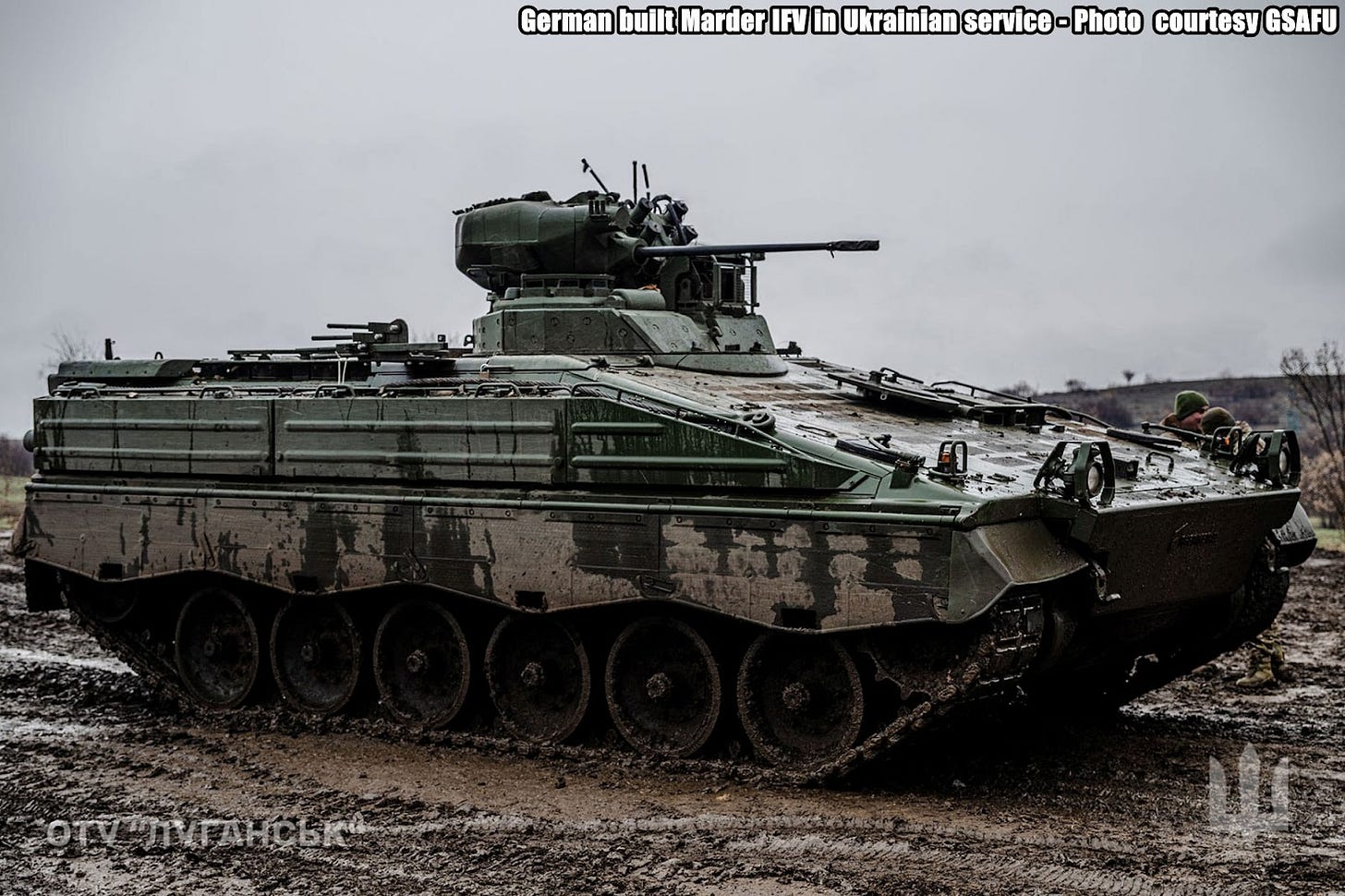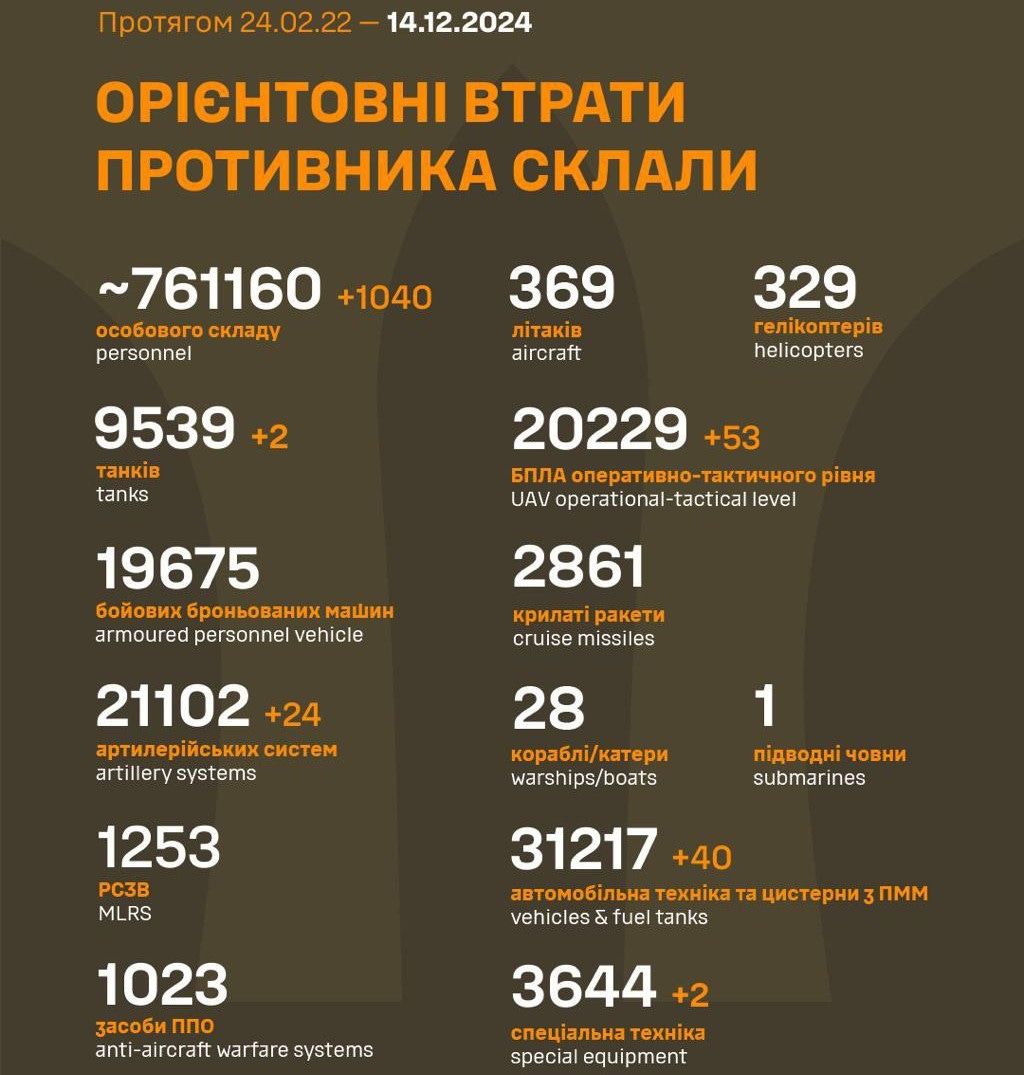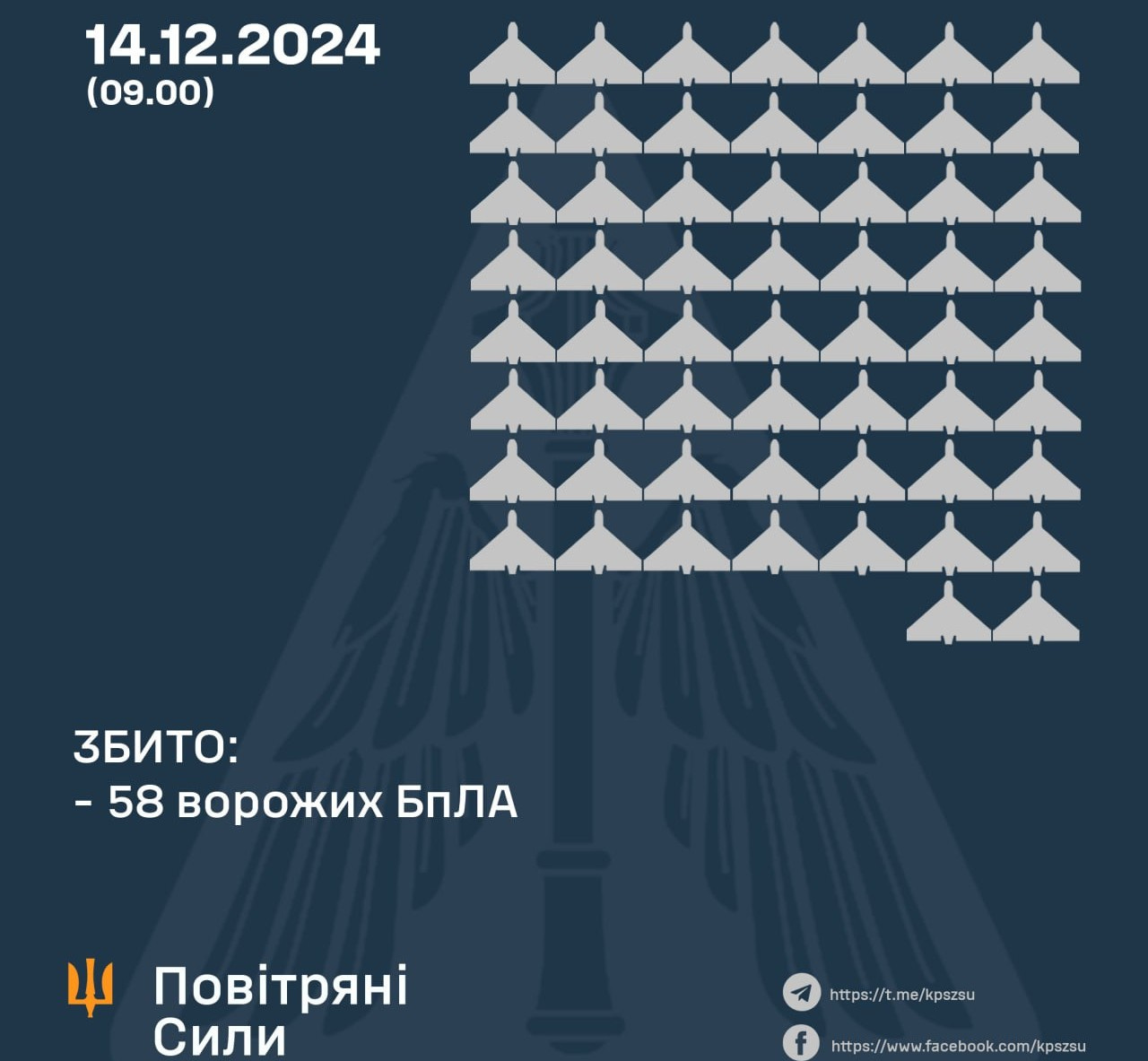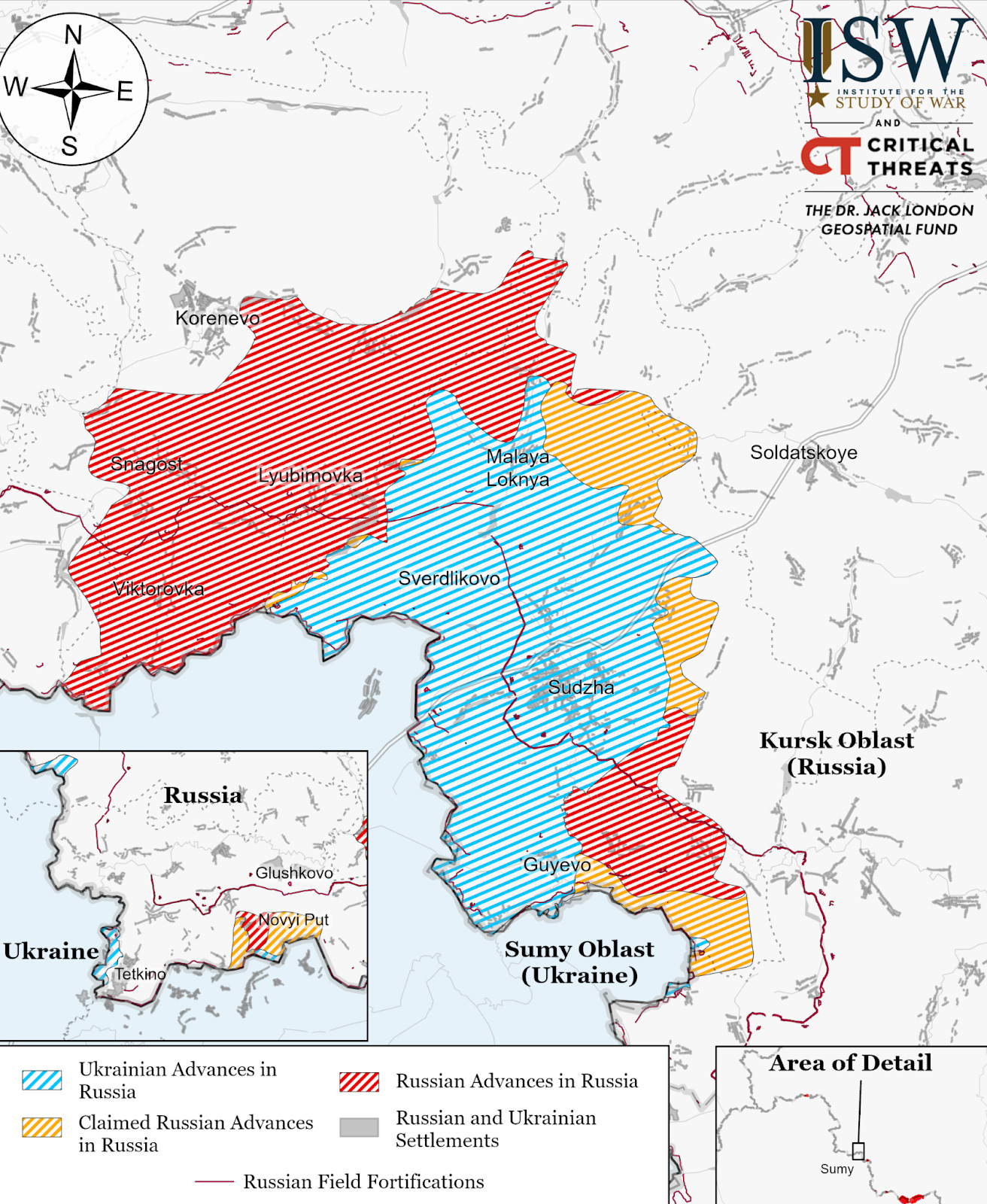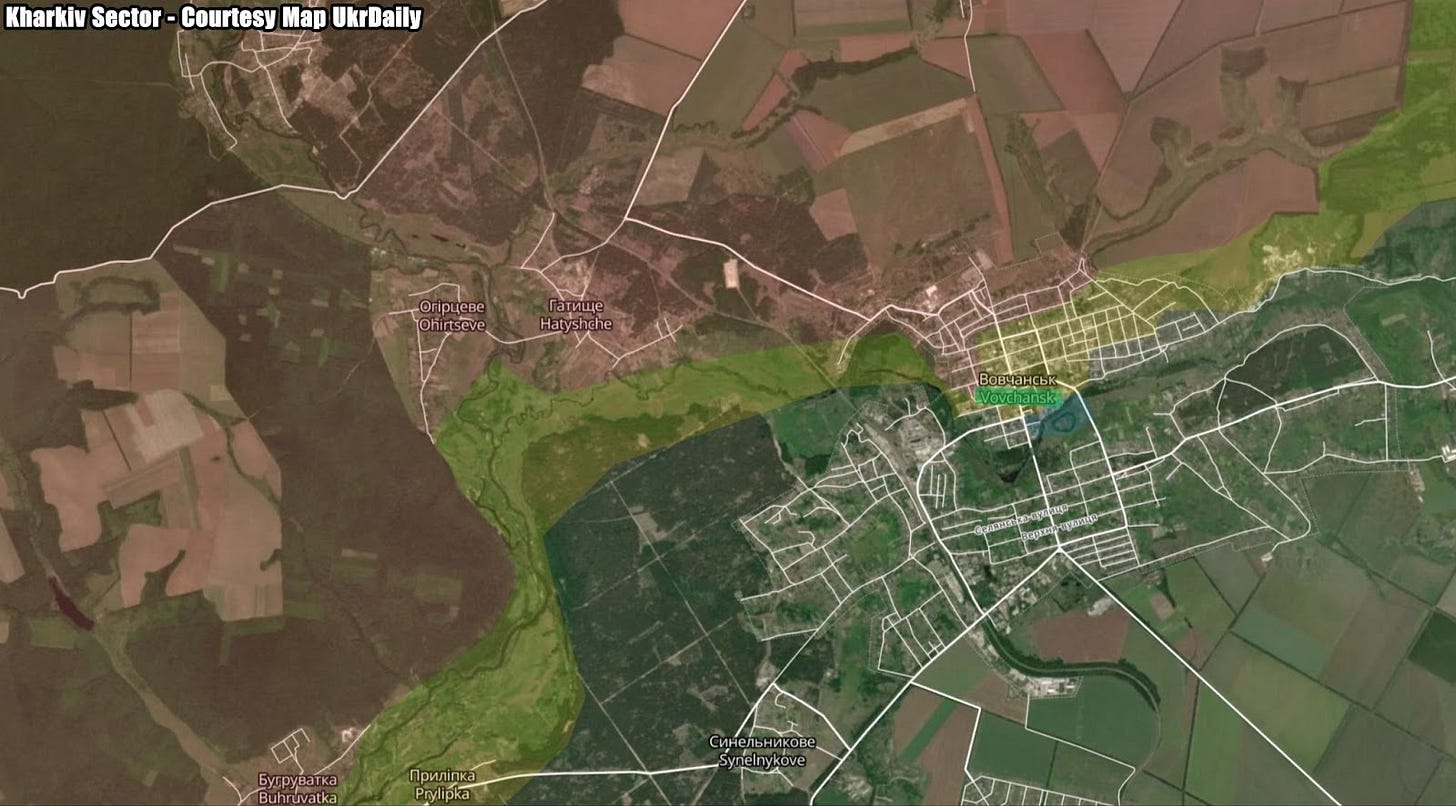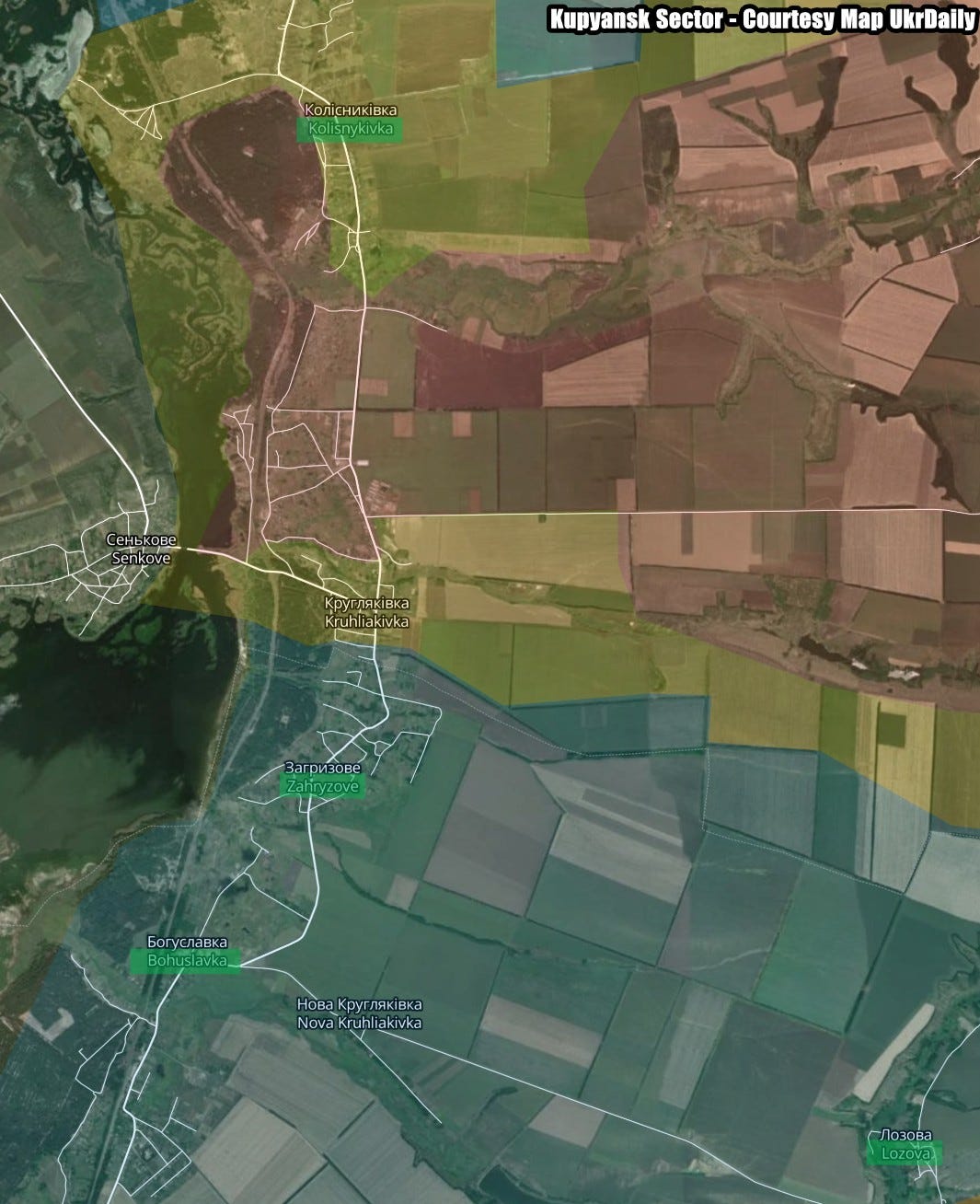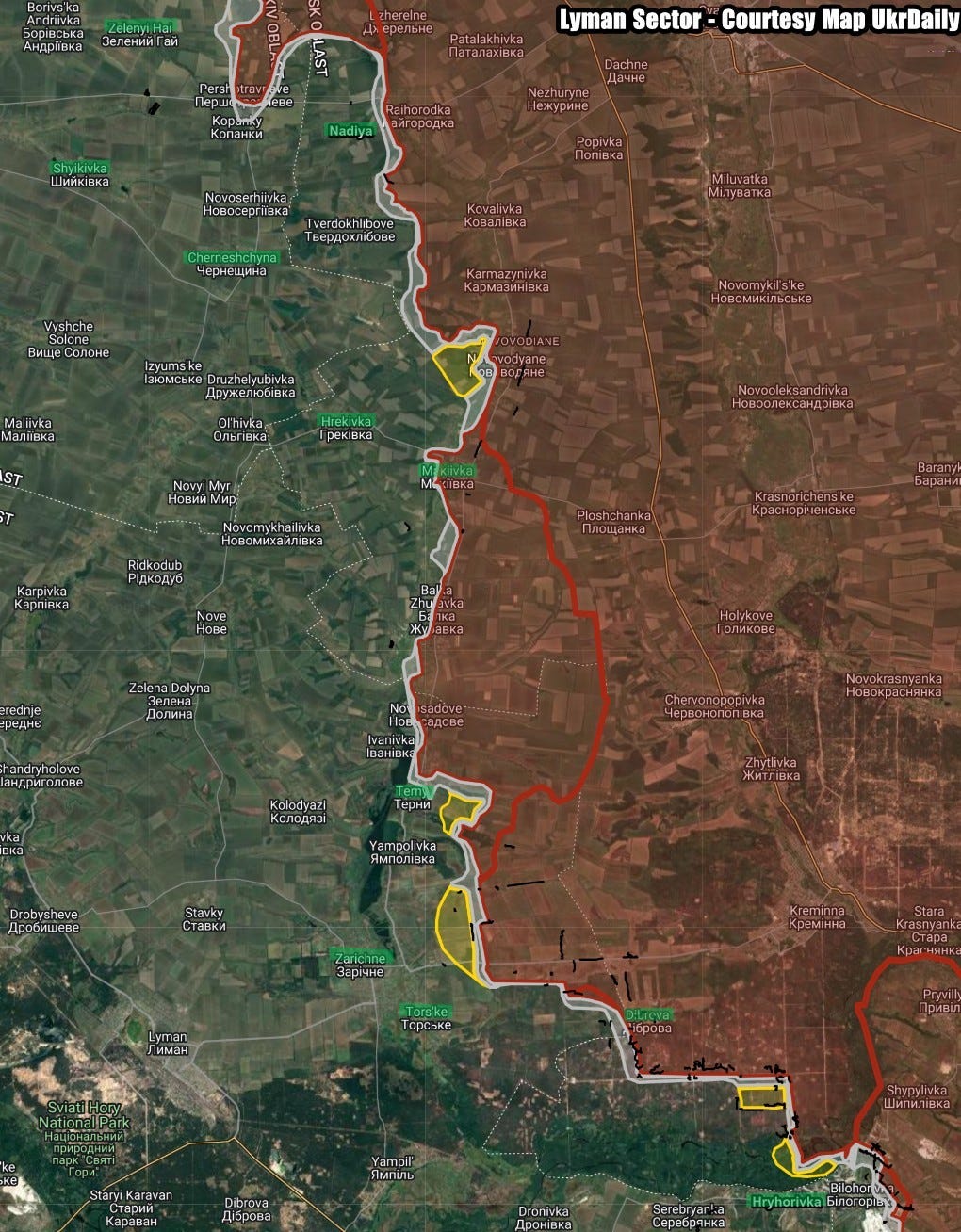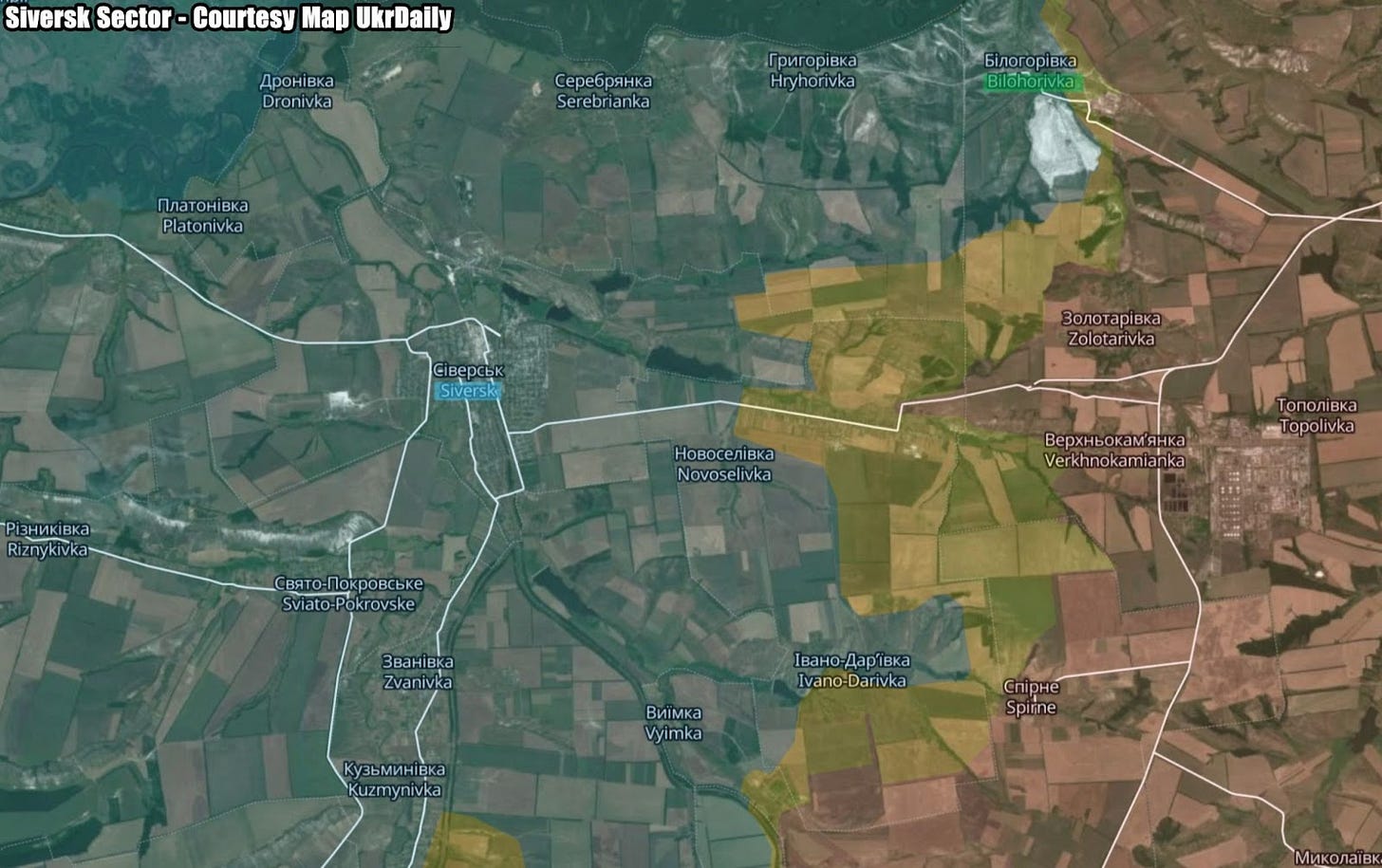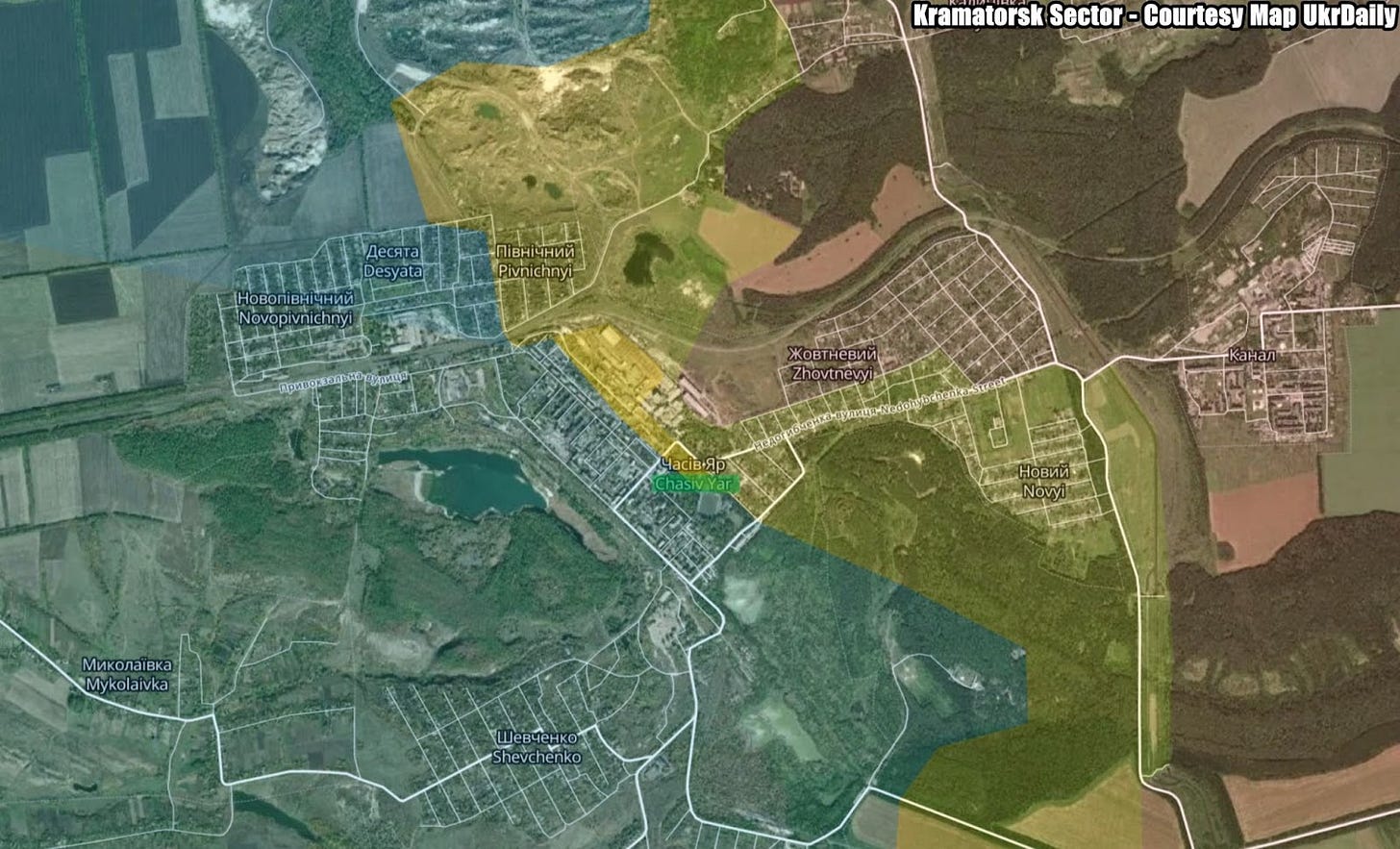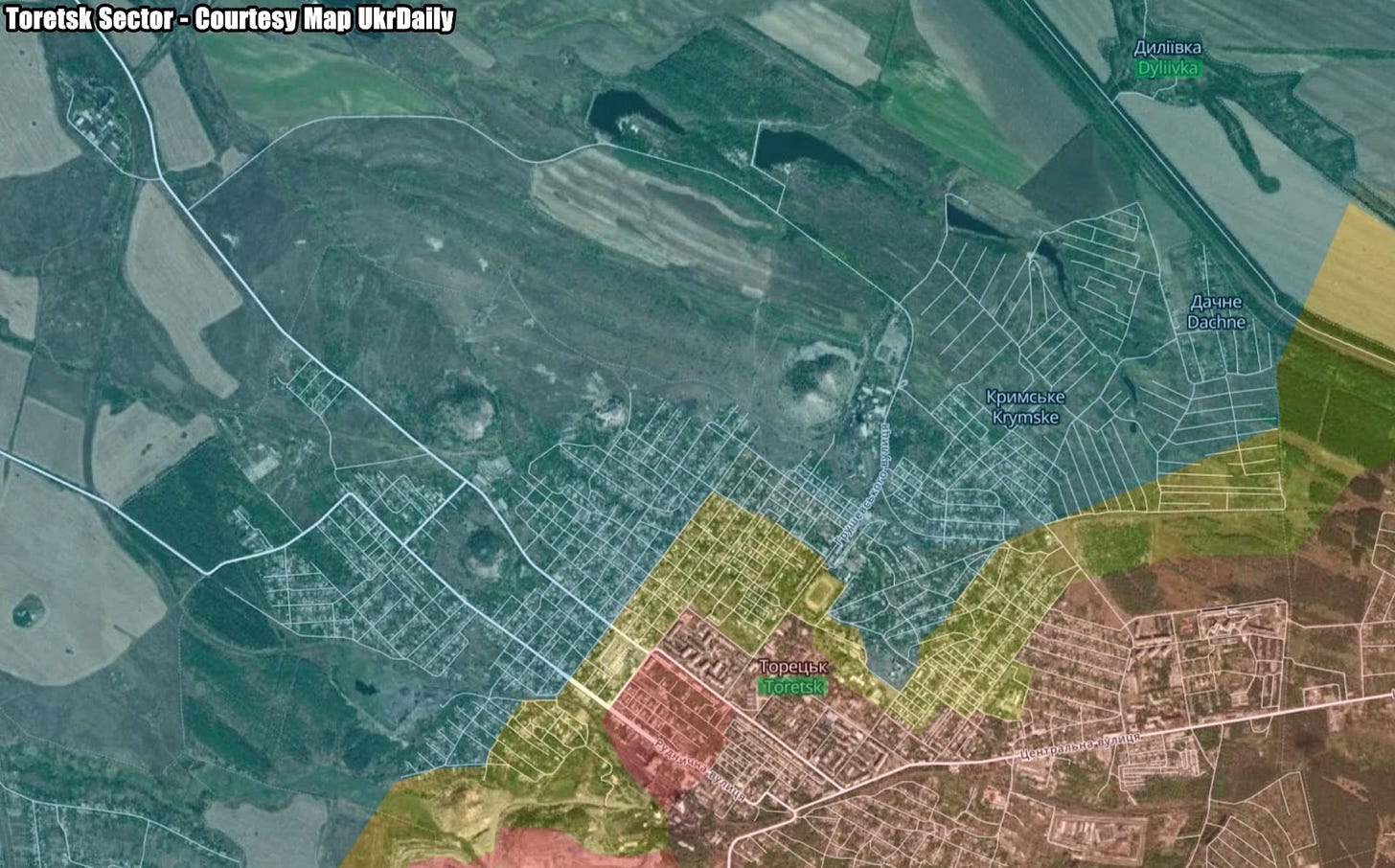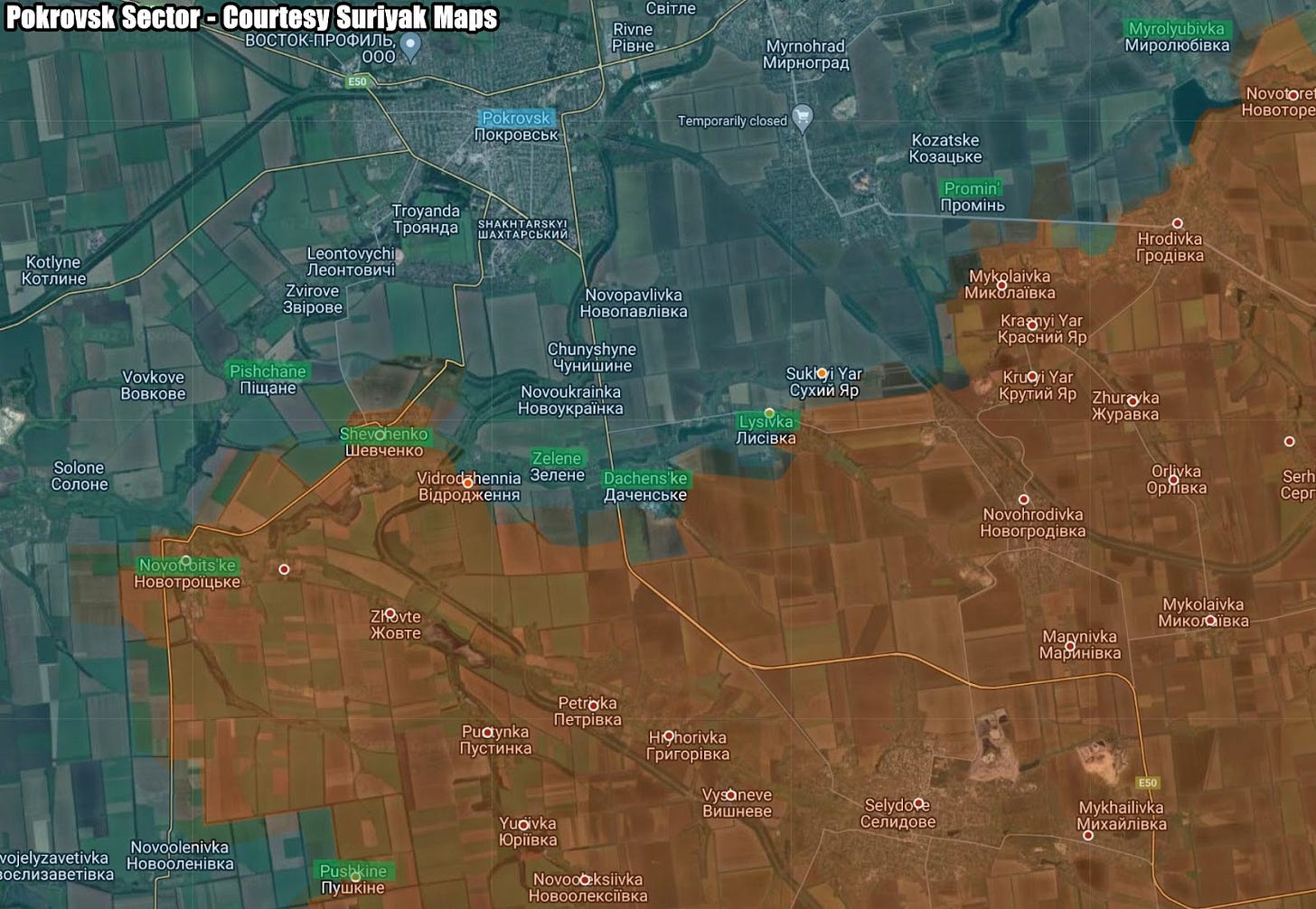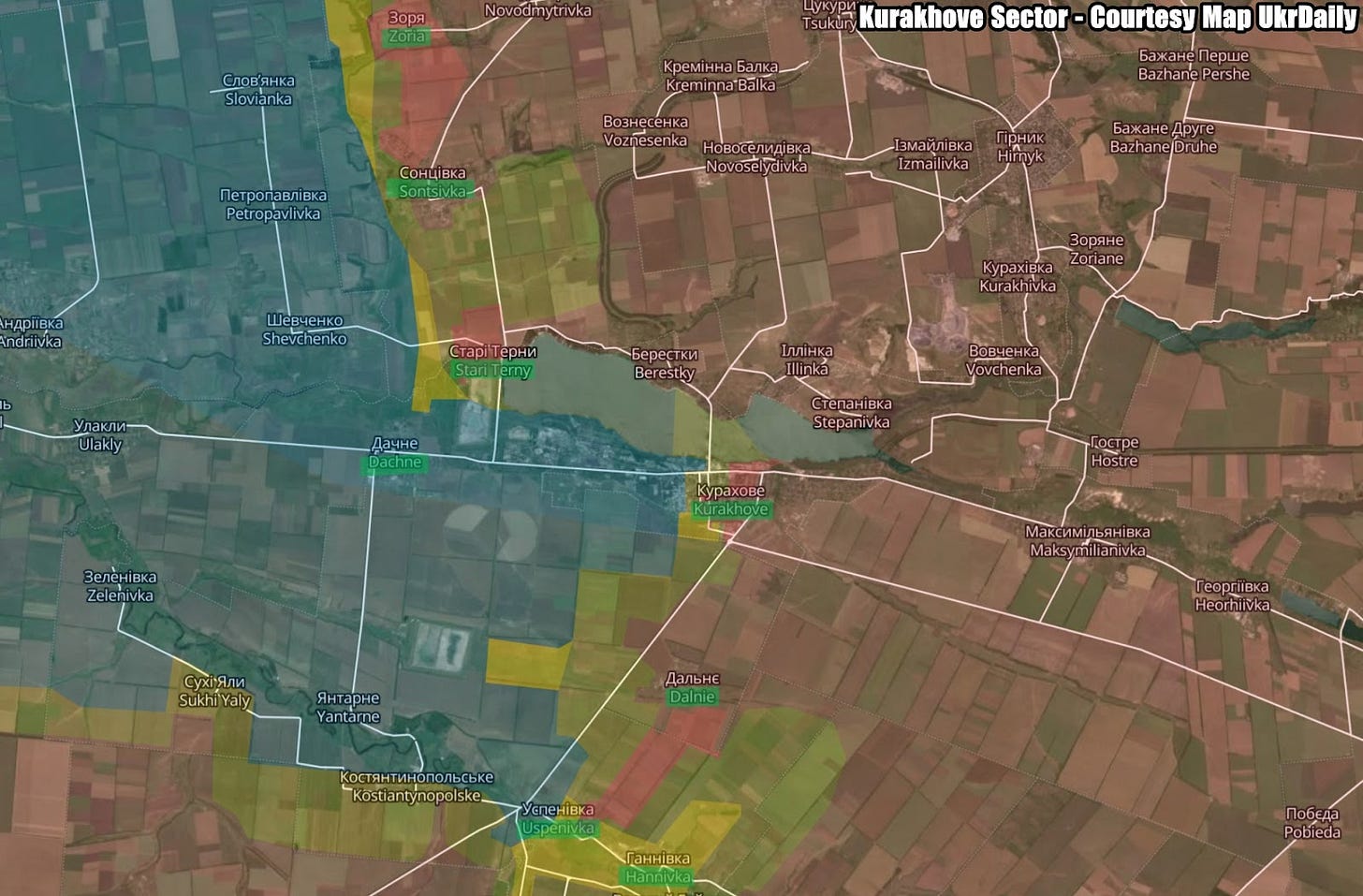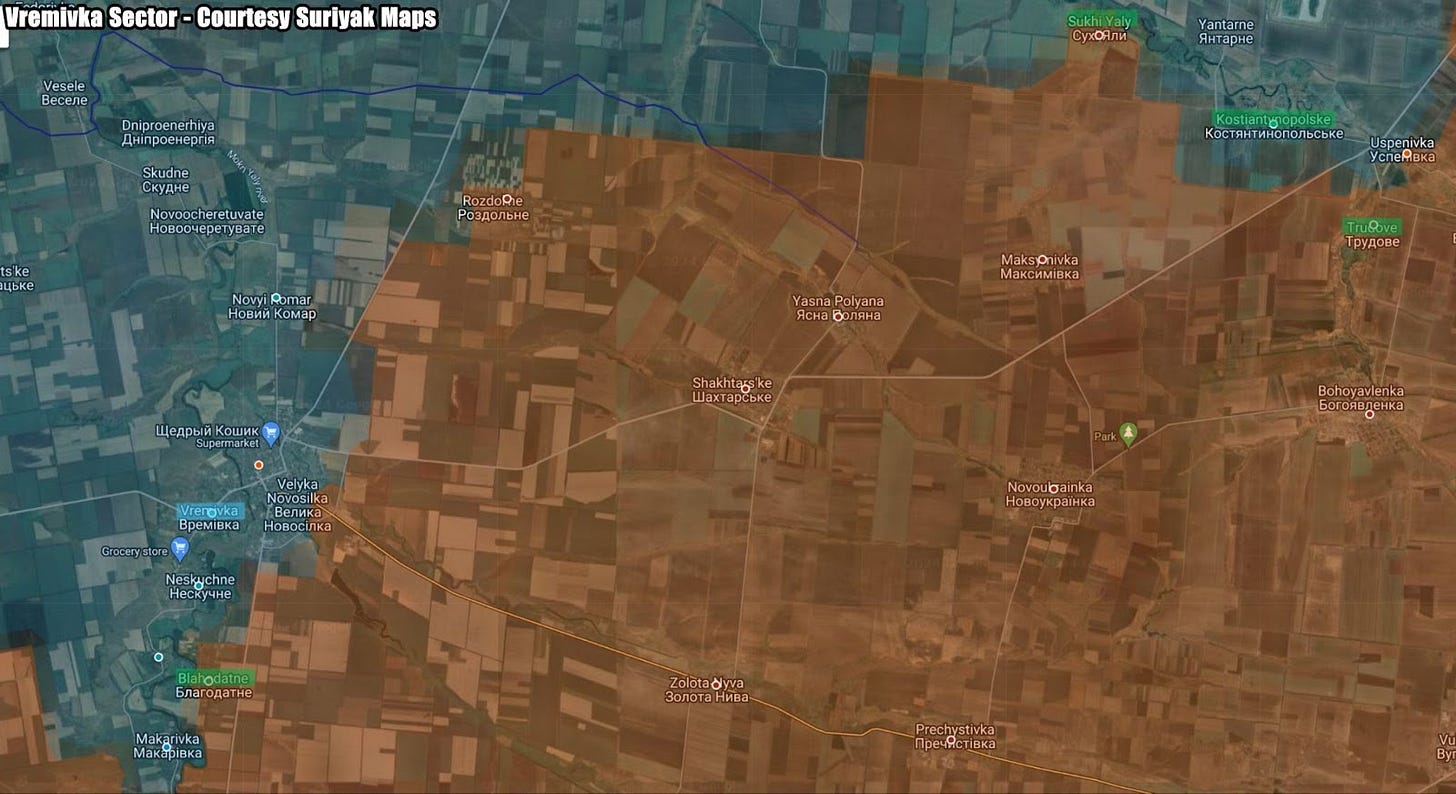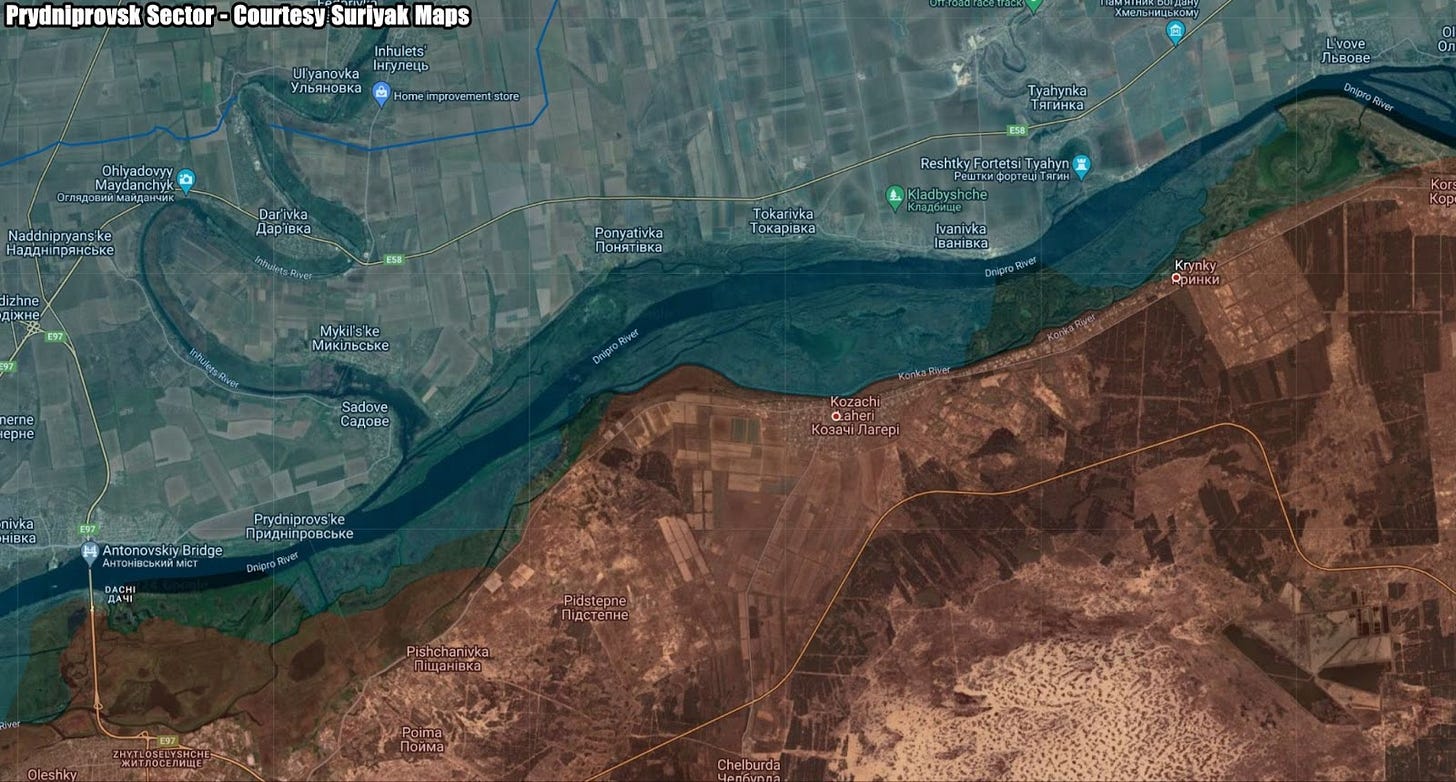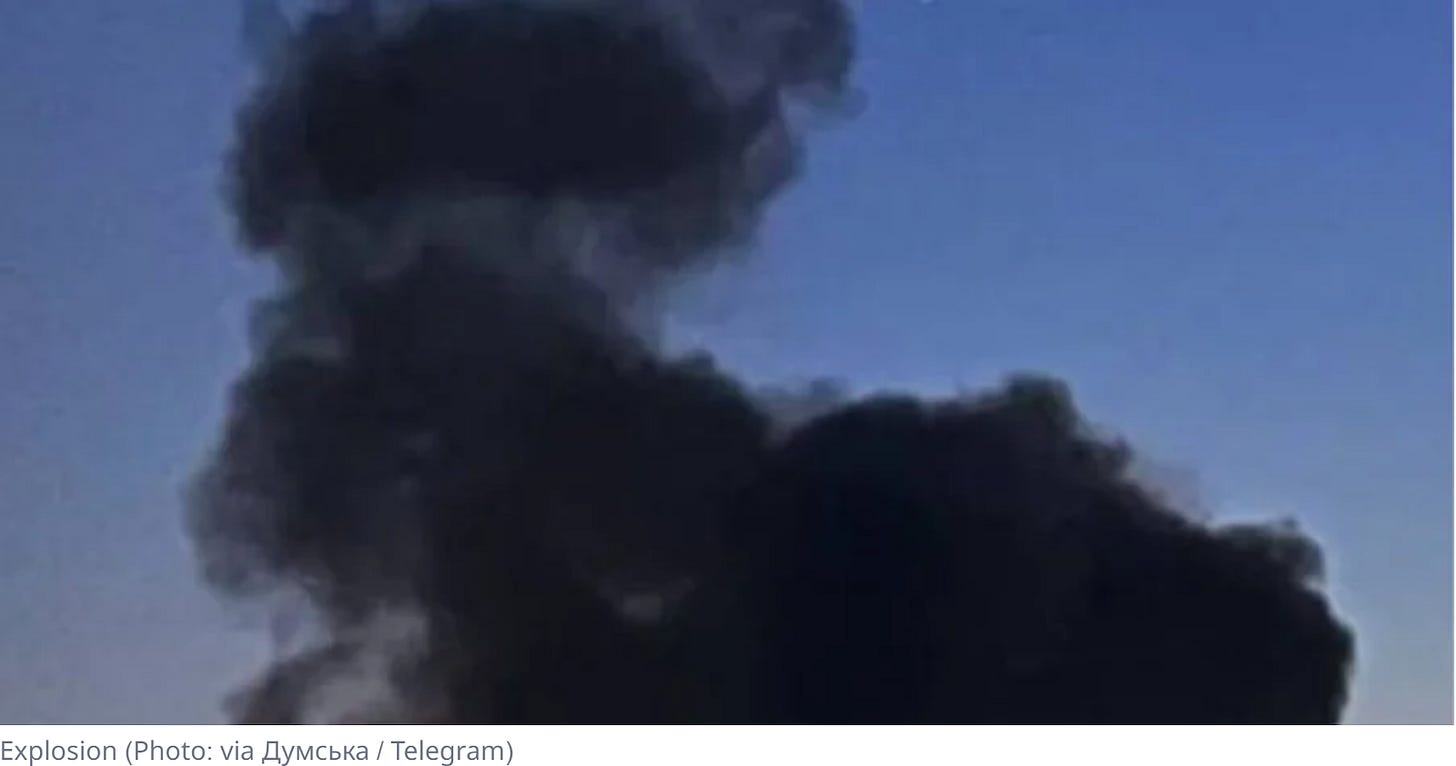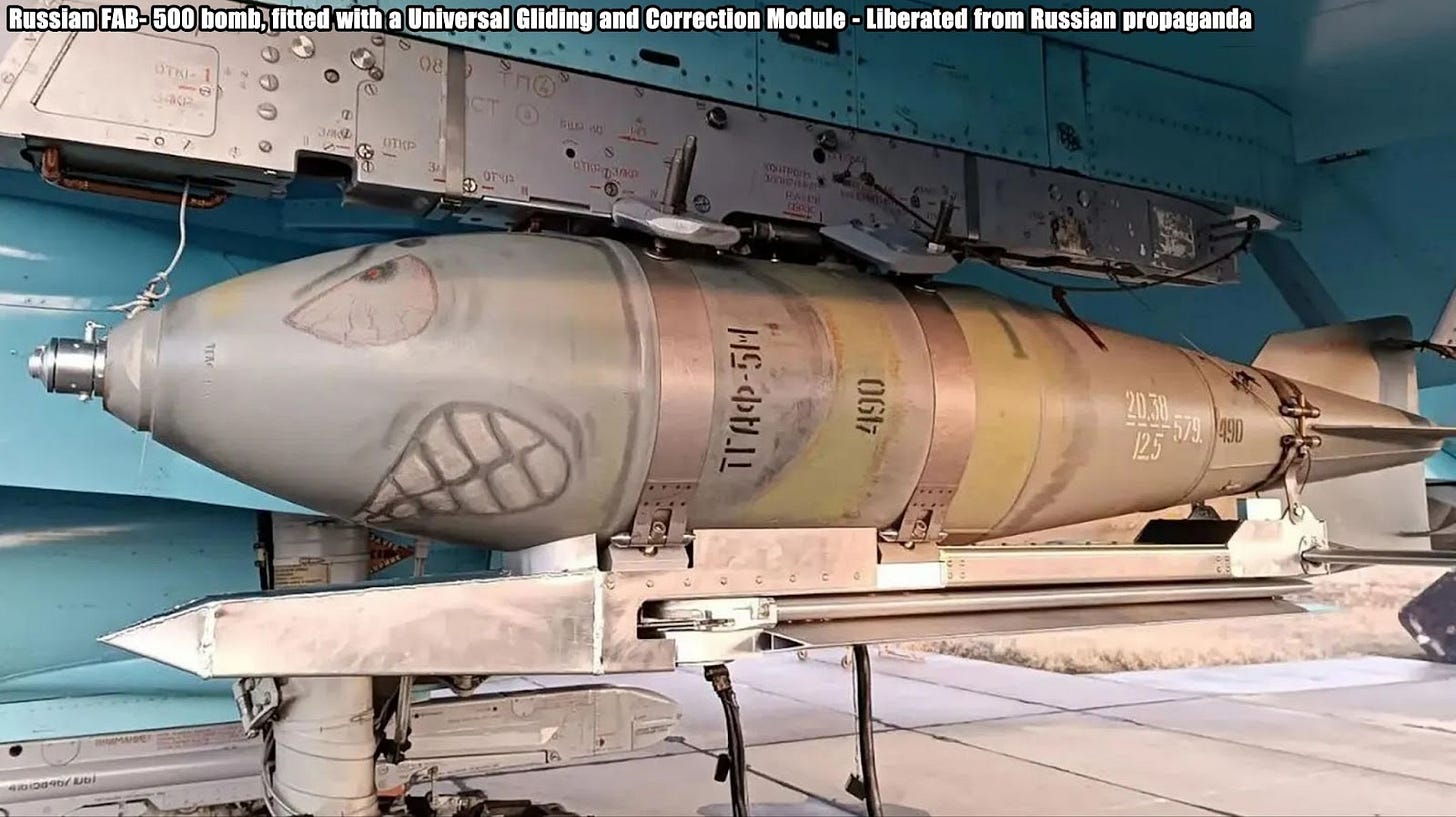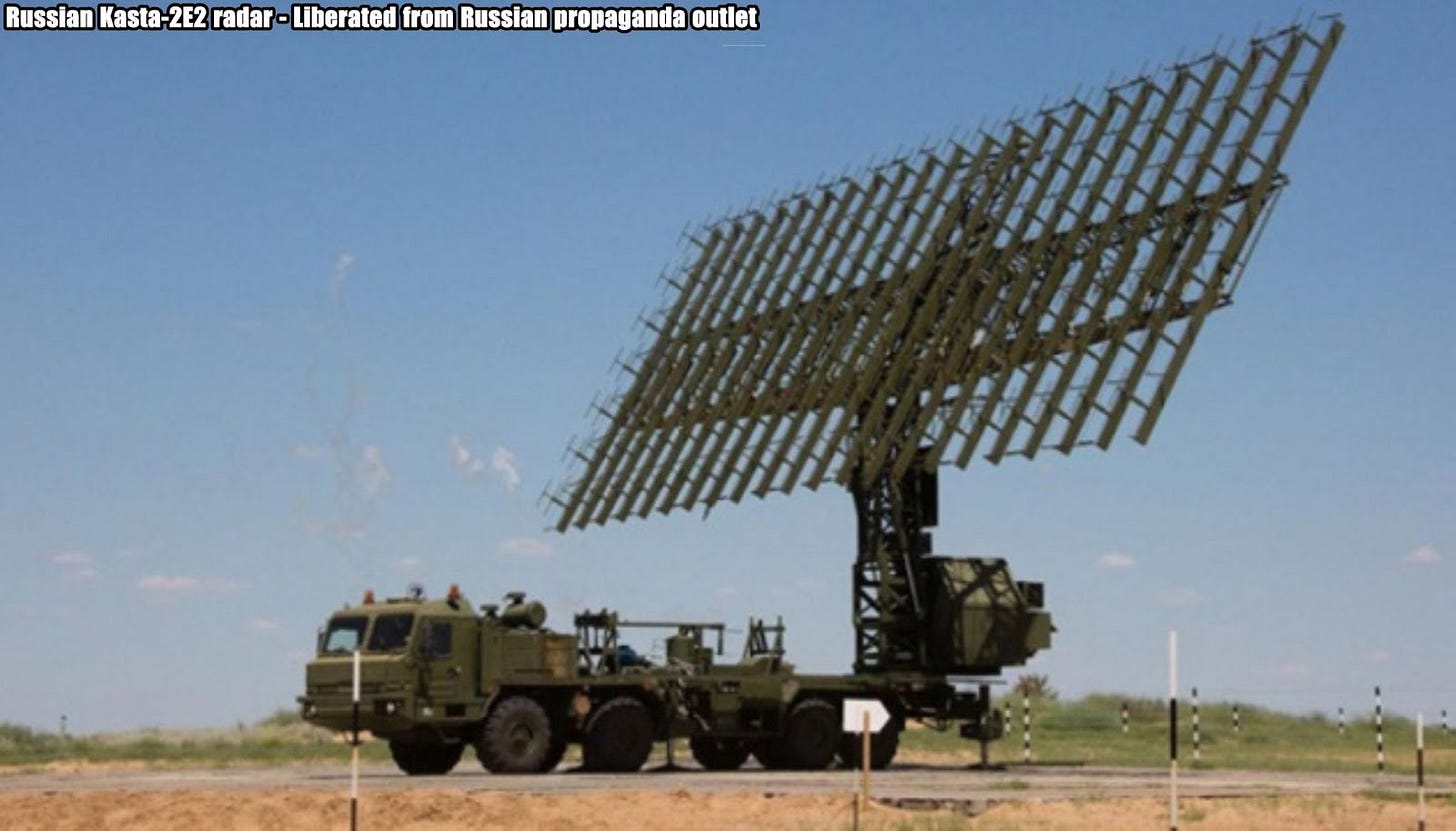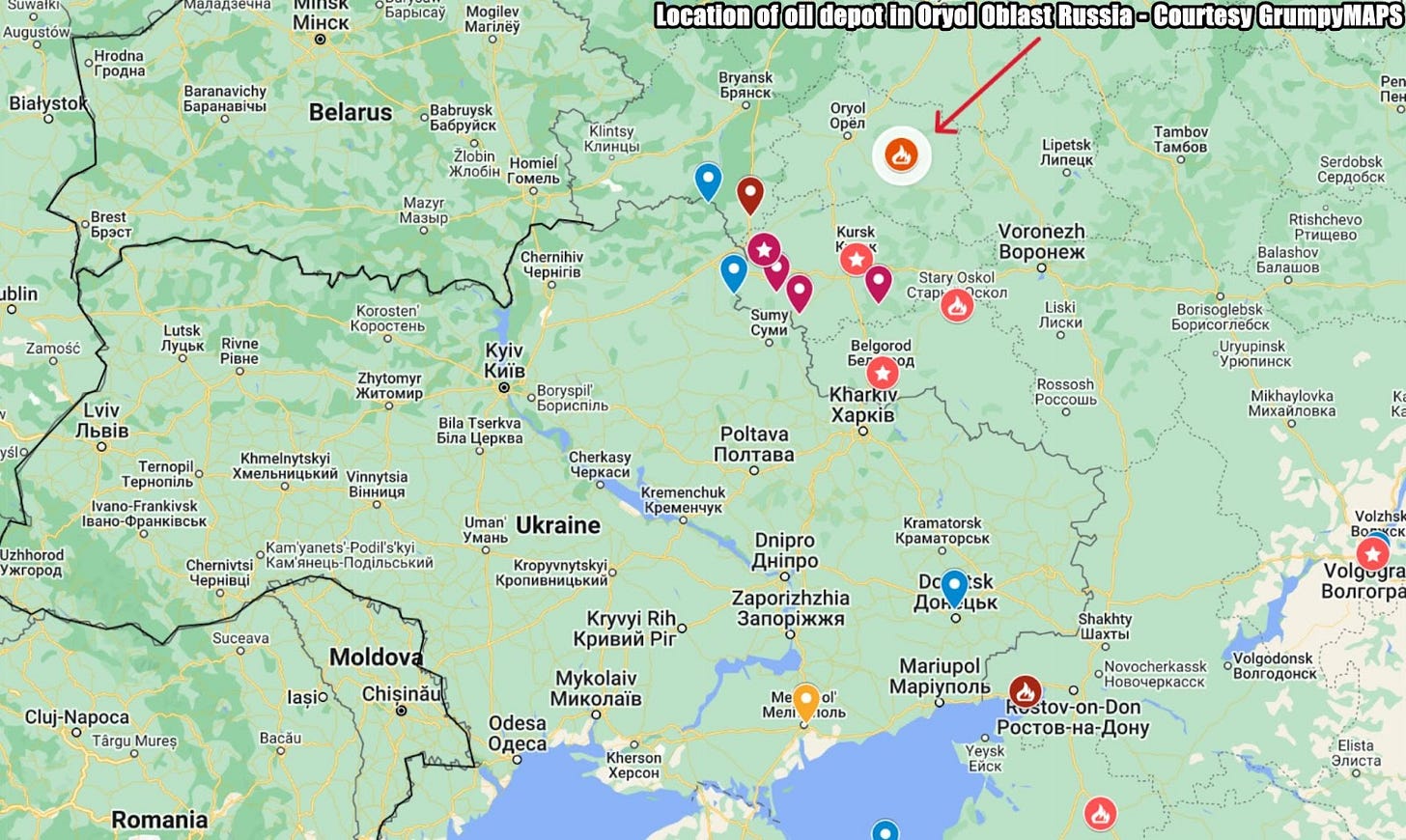Slava Ukraini! In early 2022 I began a Telegram channel aggregating news from a number of sources daily on the war in Ukraine. In June 2023 I began providing a daily draft for the Ukraine War Brief Podcast collecting news from over 70 sources daily, which formed the basis of the script. While the Podcast no longer exists I have continued to make this Brief available for my followers here on Substack for those who wish to keep up with the news from the war.
All the latest news on the Russo-Ukraine War 6 days per week
ALONG THE CONTACT LINE
GSAFU Morning Report
The General Staff of the Armed Forces of Ukraine in its Operational Information update at 22:00 on Dec 13stated that day 1025 of the full-scale invasion of the Russian Federation against Ukraine was about to begin.
During the past day, 190 combat engagements took place. Over the past 24 hours, the enemy carried out 2 missile strikes, 31 air strikes, 376 drone strikes and more than 2,500 artillery strikes across the positions of Ukrainian forces.
At the same time, Ukrainian soldiers continue to inflict losses in manpower and equipment on the occupying troops, exhausting the enemy along the entire front line and continue to disrupt the plans of Russian occupiers to advance deeper into the territory of Ukraine.
Air Force Daily Report
58 ENEMY UAVS WERE SHOT, ANOTHER 72 DRUANS FAILED TO REACH THEIR TARGETS (LOST IN LOCATION), TWO RETURNED TO RUSSIA
➖➖➖➖➖➖➖➖➖
On the night of December 14, 2024, the enemy attacked Ukraine with attack UAVs of the "Shahed" type and drones of other types from the areas of Kursk, Primorsko-Akhtarsk, Orel, Bryansk, Millerovo - Russia.
A total of 132 enemy UAVs were used in the strike.
The air attack was repelled by anti-aircraft missile troops, aviation, electronic warfare units, and mobile fire groups of the Air Force and Defense Forces of Ukraine.
As of 09:00, it was confirmed that 58 Shahed attack UAVs and other types of drones were shot down in Chernihiv, Sumy, Kyiv, Poltava, Cherkasy, Vinnytsia, Odesa, Mykolaiv, Kharkiv, Dnipropetrovsk and Kirovohrad regions. In addition, due to the active countermeasures of the Defense Forces, 72 enemy drones did not reach their targets (lost in location), two returned to Russia.
The Russian Border Incursion
The General Staff of the Armed Forces of Ukraine in its Operational Information update at 08:00 on Dec 14 stated that the Defense Forces of Ukraine repelled 22 Russian attacks over the past 24 hours. Russia conducted 13 airstrikes and 399 artillery strikes against Ukrainian positions in Kursk.
The Institute for the Study of War (ISW), a US based think tank, in its Dec 13 Russian Offensive Campaign Assessment reported that Russian forces continued offensive operations in the main Ukrainian salient in Kursk Oblast on Dec 13 but did not advance. Russian milbloggers claimed that Russian forces advanced in Nikolayevo-Darino (southeast of Korenevo), into the forested areas north of Martynovka (northeast of Sudzha), and near Kurilovka (south of Sudzha). ISW has not observed confirmation of these claims, however.
A Russian milblogger claimed that Ukrainian forces counterattacked near Cherkasskaya Konopelka (southeast of Sudzha). Russian forces continued assaults southeast of Korenevo near Novoivanovka and in Nikolayevo-Darino, northwest of Sudzha in the direction of Sverdlikovo, southeast of Sudzha near Cherkasskaya Konopelka, and south of Sudzha in the direction of Kurilovka and along the Psel River near Guevo.
North Korean special operation forces reportedly participated in the recent seizure of Plekhovo, Kursk Oblast indicating that Russia may be utilizing North Korean forces in highly attritional infantry-led assaults. Russian milbloggers claimed on Dec 12 and 13 that North Korean soldiers participated in the seizure of Plekhovo on December 6 and advanced two kilometers through minefields in order to seize the settlement over the course of two hours (ISW assesses that Russian forces seized Plekhovo as of Decr11). Several Russian milbloggers claimed that North Korean special forces seized Plekhovo with no assistance from Russian forces, but one milblogger characterized the assault as a joint Russian-North Korean operation.
Another milblogger claimed that elements of two unspecified Russian brigades are claiming responsibility for the seizure of Plekhovo despite only entering the settlement after North Korean forces seized it. ISW has not observed confirmation that North Korean soldiers have participated in combat operations in Kursk either independently or jointly with Russian forces. Ukraine’s Main Military Intelligence Directorate (GUR) reported on December 4 that the Russian command subordinated the North Korean 92nd and 94th special operations brigades in Kursk Oblast to the Russian 22nd Motorized Rifle Regiment (72nd Motorized Rifle Division, 44th Army Corps (AC), Leningrad Military District [LMD]), the 810th Naval Infantry Brigade (Black Sea Fleet [BSF], Southern Military District [SMD]), and the 11th Airborne (VDV) Brigade.
ISW previously assessed that the North Korean military's ability to learn and integrate lessons from fighting alongside Russia is likely to be significantly degraded if the Russian military command uses North Korean troops in the same highly attritional infantry-led assaults in which it normally uses most Russian personnel, including the improperly utilized VDV and naval infantry units to which the North Korean special forces are reportedly subordinated.
The Khortytsia operational-strategic group
(Responsible for the northeastern part of Ukraine. )
Kharkiv Sector: Over the last day Ukrainian Defense Forces repelled 1 Russian attack in the area of Vovchansk.
Kupyansk Sector: Russian Forces carried out 10 offensive actions against Ukrainian defensive positions near Kolisynivka, Zahryzove, Bohuslavka and Lozova. 2 engagements are ongoing.
Lyman Sector: Russian Forces carried out 24 offensive actions against Ukrainian defensive positions near Zelenyi Hai, Nadiya, Shyikivka, Cherneshchyna, Hrekivka, Makiivka, Terny, Zarichne, Torske, Dibrova and Hryhorivka. 1 engagement is ongoing.
Siversk Sector: Russian forces carried out 1 unsuccessful offensive action against Ukrainian defences in the vicinity of Bilohorivka.
Kramatorsk Sector: Throughout the day Russian forces carried out 5 unsuccessful offensive assaults against Ukrainian defences in the vicinity of Chasiv Yar.
Toretsk Sector: Over the last day Russian forces carried out 9 offensive actions with air support near Dyliivka and Toretsk. 2 engagements are ongoing.
The Tavria operational-strategic group
(Responsible for the central-eastern and southeastern part of Ukraine.)
Pokrovsk Sector : Over the last day, the highest intensity of combat was in this sector, Russian Forces carried out 56 offensive actions against Ukrainian defensive positions in the vicinity of Myrolyubivka, Promin, Lysivka, Dachenske, Zelene, Shevchenko, Pishchane, Novotroitske and Pushkine. 10 engagements are ongoing.
Kurakhove Sector: Russian Forces carried out 26 offensive actions against Ukrainian defensive positions near Zorya, Sontsivka, Stari Terny, Kurakhove, Dachne, Dalnie, Uspenivka and Hannivka. 6 engagements are ongoing.
Vremivka Sector: Russian forces made 34 attempts to break through Ukrainian defences in the vicinity of Zelene Pole [not shown on map], Blahodatne, Storozheve, Sukhi Yaly, Kostiantynopolske and Trudove. 10 engagements are ongoing.
Orikhiv Sector: In this sector, over the last day, there has been no significant change in the combat environment.
The Odesa operational-strategic group
(Responsible for Kherson, Qırım, (also known as Crimea) and the Black Sea.)
Prydniprovsk Sector: In this sector, over the last day, there has been no significant change in the combat environment. Russian forces made 2 unsuccessful attempts to dislodge Ukrainian units from their positions.
TEMPORARILY OCCUPIED TERRITORIES
Nothing major to report.
THE HOME FRONT
Explosions in Odesa, reports suggest ballistic missile attack
Explosions hit Odesa on Dec. 14, reportedly from a Russian Iskander-M ballistic missile, local Telegram channels and monitoring groups reported, adding that the threat of further ballistic strikes persists.
Earlier, DTEK announced the cancellation of emergency power outages in Odesa and Odesa District, which had been implemented following a large-scale attack on Dec. 13.
RUSSIAN WORLD
There are signs that Ukrainian targeted strikes are affecting both the tempo of Russian glide bomb strikes and the effectiveness of Russian air defence systems.
The Institute for the Study of War (ISW), a US based think tank, in its Dec 13 Russian Offensive Campaign Assessment reported that Ukrainian strikes against military airfields in Russia and Russian air defense systems in near rear areas may be prompting a decrease in Russian air operations and glide bomb strikes against Ukraine. Russian forces launched a total of 431 glide bombs in the first 12 days of Dec 2024 according to data from the Ukrainian General Staff after reportedly launching 1,472 glide bombs in the first 12 days of November 2024 and over 3,300 glide bombs total throughout November 2024. Russian forces are thus currently on track to launch only a third of the total number of glide bombs that Russian forces launched in November 2024 this month.
Russian opposition news outlet Agentstvo noted on Dec12 that Russian glide bomb strikes significantly decreased after Ukraine conducted its first strikes into Russia using Western-provided long-range weapons systems in mid-Nov 2024. Ukrainian forces conducted the first ATACMS strike on Russian territory on the night of Nov 18 to 19 and a Storm Shadow strike on Russian territory on the night of Nov 19 to 20, and data from the Ukrainian General Staff indicates that Russian forces began consistently launching fewer than 100 glide bombs per day on Nov 22.
The threat of Ukrainian strikes against Russian airfields within ATACMS and Storm Shadow range may be forcing the Russian military to base aircraft at airfields further within Russia and complicating Russia's ability to conduct glide bomb strikes on Ukraine.
Ukrainian forces have also undertaken a concerted campaign to strike Russian radars and air defense systems in occupied Ukraine and near rear areas of Russia since late October 2024. This campaign could be degrading Russia's air defense umbrella, particularly over occupied Ukraine, to the point that Russian pilots are increasingly unwilling to operate and conduct glide bomb strikes against frontline areas and rear Ukrainian cities.
Ukrainian human rights organization Truth Hounds estimated in a recent report that Ukrainian forces destroyed at least 33 Russian Su-34 fighter aircraft between Feb 2022 and Sept 2024, and the International Institute for Strategic Studies (IISS) previously estimated that Russia has approximately 112 various Sukhoi fighter aircraft. ISW is unable to confirm or verify the Truth Hounds' report. The destruction of nearly 30 percent of Russia's Sukhoi aircraft, could, if true, also impact Russia's ability to conduct glide bomb strikes against Ukraine, although it is unclear when these losses took place relative to the recent drop in glide bomb attacks.
Ukrainian intelligence expects North Korean troops to take part in assaults very soon
Defence Intelligence of Ukrainian (HUR) released a report stating they believe that the Russian command will soon involve the North Korean (DPRK) military in direct assault operations.
Ukrainian intelligence noted that the North Korean military had recently received additional food supplies.
On 13 December, the North Korean army units were put on alert and ordered to wait for further instructions.
"The command of the North Korean army units in Russia has received an order to enter into cooperation with Russian units engaged in combat operations in Kursk Oblast… Some of the DPRK troops are being covertly transferred to the front line by civilian trucks that look like water delivery vehicles."
Russia Packs Up Military Equipment at Syrian Base
Russia appears to be packing up military equipment at its airbase in Syria, satellite images released by Maxar on Friday showed. The Moscow Times reports.
The fate of Moscow's military presence in Syria, a key foothold for its presence in the Middle East and Africa, has been unclear since Russian-backed President Bashar al-Assad's regime was overthrown by Islamist rebel forces, forcing him to flee to Moscow.
Maxar imagery shows two An-124 heavy transport aircraft at Russia's Khmeimim airfield with their nose cones opened to load heavy equipment as well as helicopters being dismantled and readied for transport.
Russian S-400 air defense systems have also been moved from their previous deployment site at the airbase.
The Russian Navy base at Tartus has remained largely unchanged since Wednesday, the images showed.
"While tactical aviation is still there, [Russia] appears to be consolidating at Khmeimim and Tartus. In short, a withdrawal is under way," Michael Kofman, a senior fellow at the Carnegie Endowment, wrote on X.
"Still unclear if this is a complete exit. There are indications and rumors to that effect, but best to wait for the evidence," he said.
Russian diplomats told The Moscow Times this week that a complete Russian withdrawal from Syria, including the Tartus naval base and the Khmeimim airbase, was likely.
On Sunday, as anti-Assad forces captured the territories where Tartus and Khmeimim are located, Russia’s Foreign Ministry said that it was in contact with the insurgents and had received security guarantees.
Russia was continuing to discuss the fate of its military infrastructure in the country with Syria's new leadership, the Kremlin said Wednesday.
"We are in contact with those who control the situation in Syria. This is necessary since our [military] base and diplomatic mission are there," Kremlin spokesman Dmitry Peskov said.
The Tartus naval base and Khmeimim air base in Syria are Russia's only military outposts outside the former Soviet Union and have been key to the Kremlin's activities in Africa and the Middle East.
Russia's 2015 intervention turned the tide of the Syrian civil war and is widely credited with saving Assad's regime as it fought a myriad group of rebel forces.
But with Moscow bogged down with its military offensive on Ukraine, some analysts say it did not have the resources or energy to come to his rescue again.
Russian Su-30 fighter jet, three locomotives destroyed in Krasnodar Krai
A Su-30 fighter jet and three locomotives were destroyed in the city of Krymsk, in Russia’s Krasnodar Krai, Defence Intelligence of Ukrainian (HUR) reported on Dec 14 via Telegram.
The report also noted that on Dec. 13, three Russian railway locomotives were disabled in the city of Krasnodar.
The HUR emphasized that these military assets were being used by Russia in its criminal war against Ukraine.
"For every war crime committed against the Ukrainian people, there will be just retribution," the statement read.
The HUR also released a video showing the sabotage operations in Russia.
Ukraine strikes oil depot in Russia's Oryol Oblast
Ukrainian drones reportedly struck an oil depot in the city of Oryol overnight on Dec 14, causing a large fire, The Kyiv Independent reports citing several Russian Telegram channels. Explosions were reported by residents in the city around midnight local time.
Andrey Klychkov, governor of Oryol Oblast, reported early on Dec 14 that 11 drones were downed over the region and the fire was localized at the oil depot. No casualties were reported.
Videos posted on social media and shot by local residents appear to show a drone hitting a storage tank and causing an explosions at an oil depot in Oryol. Local residents claimed that at least one storage tank caught fire as a result of the attack, ASTRA reported. It was not immediately clear which oil depot was targeted in the attack.
The Kyiv Independent cannot verify the claims and Ukraine's military has not yet commented on the alleged attack.
The full extent of the damage was not immediately known, and it is unclear if there are any casualties as a result of the alleged attack.
INTERNATIONAL NEWS
US considers sanctions on Chinese banks and Russian “dark fleet”
U.S. Treasury Secretary Janet Yellen told Reuters on Friday that the U.S. is looking at further sanctions on "dark fleet" tankers and will not rule out sanctions on Chinese banks as it seeks to reduce Russia's oil revenue and access to foreign supplies to fuel its war in Ukraine. Reuters reported on Dec 13.
Yellen said in an interview that the U.S. and its allies also could consider lowering their $60-per-barrel oil price cap on Russian oil, which prohibits Western insurance and maritime services on cargoes above that level.
The Treasury has already sanctioned individual tankers and their owners for operating above the price cap and can do more in this area, Yellen added, suggesting additional measures in the five weeks before she leaves office.
"There are a number of possibilities here. We don't preview sanctions, but we're always looking at oil revenues and if we can find ways to further impair Russian oil revenues, that would, I think, strengthen Ukraine's hand. That remains on our list," Yellen said.
Earlier this week, Yellen said softness in the oil market presents an opportunity for more sanctions. Benchmark Brent crude traded at $74.50 per barrel on Friday, down from $85.57 when the $60 cap was set in December 2022.
President Joe Biden's administration has been racing to shore up support for Ukraine before President-elect Donald Trump takes office on Jan. 20, given the Republican leader's frequent complaints about the cost of U.S. support for Ukraine.
U.S. Treasury officials continue to have conversations with their Chinese counterparts on efforts to detect financial institution activity that could be aiding transactions related to Russia's war effort. Yellen said these discussions have been aided by efforts to rebuild U.S.-China economic and financial communications over the past two years.
"I absolutely would not rule out the possibility we would sanction an individual bank if we had the necessary level of ... evidence to be able to put sanctions on," she said. "But we also do have a channel where we've been able to discuss specific concerns, and sometimes that could be adequate as well."
She said warnings to larger Chinese banks have been successful, making them "very wary" of sanctions that would cut them off from dollar-based transactions. In an executive order about a year ago, Biden gave Treasury the authority to levy secondary sanctions on financial institutions that facilitate war-related transactions.
As Russia's economy becomes more dominated by military production, it is becoming harder to distinguish between strictly commercial and war-related deals.
"Authorities in China recognize that our use of these sanctions would be a serious threat with very adverse consequences," Yellen said. "They want to trade with Russia, but they do not want their banks sanctioned."
EU to impose sanctions on Russian intelligence over disinformation campaigns
The European Union is proposing to sanction more than a dozen individuals and three entities as part of the bloc’s first set of measures hitting Russia for its disinformation operations and other hybrid activities. Bloomberg reported on Dec 13.
The proposed measures would hit several Russian intelligence officers and groups, as well as government officials and media entrepreneurs, according to a draft seen by Bloomberg.
The restrictions are part of a new sanctions regime approved earlier this year that focuses on disinformation operations and other Russian-sponsored destabilizing activities globally.
The bloc is also proposing further sanctions on Belarus, including on about two dozen individuals accused of human-rights violations or benefiting materially from their relationship with the government of President Alexander Lukashenko.
EU foreign ministers aim to approve the packages when they meet Monday in Brussels, ahead of elections scheduled to take place next month in Belarus.
The proposals come as the EU agreed on the 15th package of sanctions on Russia over its full-scale invasion of Ukraine. Those measures include restrictions on more than 45 oil tankers involved in covertly shipping Russia’s crude and several Chinese entities accused of helping Moscow develop attack drones.
MILITARY & TECH
F-16 Training Center in Romania Reaches Full Capacity
The European F-16 training center, which is currently training Ukrainian pilots, has received all 18 fighters from the Netherlands Defense Express reports.
The European F-16 Training Center (EFTC), where Ukrainian pilots are also trained, has reached full capacity and received a full staff of aircraft.
According to Defense Romania, this was made possible by the Netherlands, which donated 18 fighter jets to the center in Romania. The publication also notes that the efforts of American Lockheed Martin, which provided the center with instructors, should not be forgotten.
As Defense Express, we should note that starting in 2025, the EFTC in Romania will be the only center in Europe to train pilots and technicians on these fighters. This is because a similar center in Denmark at Skrydstrup Air Base is being shut down due to the country's transition to the F-35.
Grumpy Here - On Dec 14 Norway announced it would continue to train Ukrainian pilots for its F-16 program but would be moving the location from Denmark to Portugal
Thus, the pace of Ukrainian pilots' training on the F-16 will largely depend on the EFTC's capacity, as the only alternative currently available is training centers in the United States.
It should be recalled that, according to an official statement by the Ministry of National Defense of Romania, four Ukrainian pilots are currently undergoing training at EFTC. They arrived at the center in September and, if they complete the standard 8-month course, are expected to graduate around May 2025.
That’s it for today’s Brief folks if you would like to keep up with events in Ukraine daily please consider subscribing.
Feel free to share this update with your friends. Heroyam Slava!







